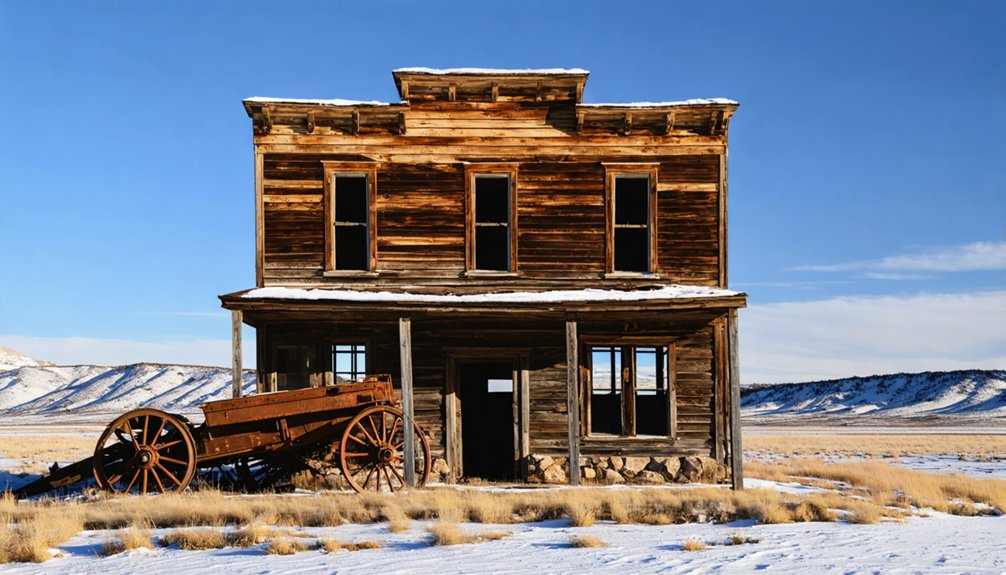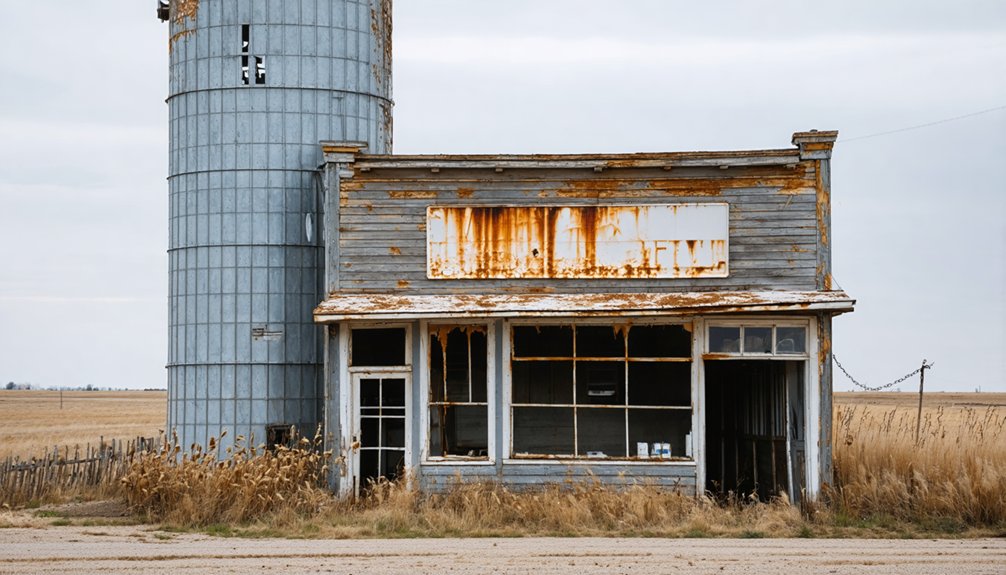The Great Plains hold remarkable frontier ghost towns that reveal America’s westward expansion story. You’ll find Bodie, Nebraska’s abandoned rail beds; Nicodemus, Kansas, the last surviving Black Exoduster settlement; Ingalls, Oklahoma, site of an infamous 1893 shootout; Glenrio, Texas, a Route 66 waypoint; Bannack, Montana’s gold rush capital; Pawnee, North Dakota’s Dust Bowl casualty; and Fort Totten, South Dakota, where military objectives transformed into cultural assimilation. Each weathered structure whispers tales of boom, bust, and perseverance.
Key Takeaways
- Bodie, Nebraska offers railroad history with remnants including overgrown rail beds and grain elevators from its timber transportation past.
- Nicodemus, Kansas stands as the last surviving Exoduster settlement and is preserved as a National Historic Site with original structures.
- Ingalls, Oklahoma features crumbling foundations and historical markers from its notorious past as sanctuary for the Doolin-Dalton Gang.
- Glenrio, Texas showcases Route 66 history with abandoned businesses that once exploited unique cross-border commerce opportunities.
- Bannack, Montana preserves Montana’s first territorial capital with historic structures accessible for winter tours via snowshoe or ski.
Bodie, Nebraska: The Railroad Town That Time Forgot
Nestled in the rolling prairies of Nebraska, Bodie emerged as a quintessential frontier settlement when the Bodie Railway and Lumber Company established operations on February 19, 1881. This narrow-gauge railroad transformed the speculative outpost into a functioning community, connecting residents to essential timber resources and distant markets.
If you explore Bodie today, you’ll find only whispers of its railroad history—overgrown rail beds, scattered building foundations, and solitary grain elevators standing as sentinels of a bygone era. The railway once efficiently transported lumber from Mono Mills where workers could process an impressive 80,000 board-feet of timber in just 10 hours. The company initially built temporary spurs into the timberlands to maximize harvesting efficiency.
The town’s decline mirrors countless other Plains settlements that withered when rail traffic diminished. As larger towns absorbed regional trade, Bodie’s population scattered to communities with better connections.
Despite its abandonment, Bodie’s remnants offer valuable insights into how railroad economics shaped frontier development and ultimately determined which settlements would survive.
Nicodemus, Kansas: Last Remaining Exoduster Settlement
A reflection of Black determination in the post-Civil War era, Nicodemus stands as America’s last surviving Exoduster settlement. Founded in 1877 by six Black Kansans and a white developer, this prairie town became a beacon of hope for freedmen fleeing southern oppression during the Black Migration northward.
You’ll find a poignant story of resilience here. Early settlers constructed sod homes and endured harsh winters, receiving vital aid from the Osage Nation. The end of Reconstruction in the South sparked this significant migration as African Americans sought freedom from oppression. The town’s original settlers, primarily from Kentucky, believed land ownership was essential for achieving true freedom in America.
Though the railroad’s bypass in 1888 triggered the community’s decline, Nicodemus refused to disappear entirely.
Today, this National Historic Site preserves a limestone township hall, Baptist church, and original homes—physical reminders of Black pioneers’ frontier dreams.
With only about 18 current residents, Historical Preservation efforts by descendants guarantee this remarkable chapter in America’s westward expansion isn’t forgotten.
Ingalls, Oklahoma: Ghost Town of Frontier Justice
While Nicodemus represents Black pioneers’ struggle for freedom, Ingalls, Oklahoma stands as a stark monument to frontier lawlessness and the violent clash between outlaws and authority. Founded in 1889, this settlement quickly became notorious as a sanctuary for the Doolin-Dalton Gang, whose outlaw legacy peaked during the infamous Battle of Ingalls on September 1, 1893.
You’ll find little remaining of this once-thriving community—just crumbling foundations and weathered markers about 10 miles east of Stillwater. The site now includes a replica of the Old Ingalls Hotel, where visitors can visualize the historic shootout that changed the town’s trajectory. The ghost town offers no tourist amenities, just authentic ruins where a dozen marshals once engaged in a bloody shootout with desperados like “Dynamite Dick” and “Bitter Creek.” The town’s strategic position on the open prairie provided early warning systems when law enforcement approached, giving outlaws precious time to escape.
The town’s decline followed its post office closure in 1907, leaving only silent prairie where unmarked outlaw graves lie forgotten beneath tall grass.
Glenrio, Texas: The Interstate Border Community That Vanished
When you stand at the abandoned Glenrio settlement, you’re witnessing a town literally divided by state lines, with Texas-side gas stations (avoiding New Mexico’s higher fuel taxes) facing New Mexico-side bars (circumventing Texas’ dry laws).
This unique border community thrived as a critical waypoint on Route 66, serving countless travelers with its strategically positioned businesses that exploited interstate legal differences. The town was originally established in 1903 when the Chicago, Rock Island and Pacific Railroad arrived in the area.
The town’s prosperity evaporated almost overnight when Interstate 40 opened in 1973, bypassing Glenrio entirely and transforming a once-bustling transportation hub into the preserved ghost town you’ll find today. This historic site was formally recognized when Glenrio was officially listed in the National Register of Historic Places in 2007.
Historic Split Jurisdiction
Straddling the invisible line between Texas and New Mexico, Glenrio emerged in 1905 as a community literally divided by state jurisdiction.
You’d find this border town‘s unique geography created fascinating adaptations to cross-border commerce, with businesses strategically positioning themselves to leverage the most favorable laws.
The jurisdictional challenges were evident everywhere you looked: bars operated exclusively on New Mexico’s side due to Texas’s dry county status, while gas stations clustered on the Texas side to avoid New Mexico’s higher fuel taxes.
Even official services were split—the post office stood in New Mexico while mail arrived at the Texas depot. The town gained brief Hollywood fame when it served as a filming location for scenes in the 1940 movie Grapes of Wrath.
The town’s name itself reflects its cross-cultural identity, combining the Scottish and Spanish words “Glen” meaning narrow valley and “Rio” meaning river.
The federal government generally considered Glenrio a Texas town, yet the community functioned as a single entity despite being governed by two different state legal systems.
Transportation Corridor Evolution
Although initially established as a railroad settlement, Glenrio’s transportation identity underwent a dramatic metamorphosis throughout the 20th century.
You can trace its evolution through three distinct phases: first as a Chicago, Rock Island and Gulf Railway outpost established in 1906, then as a Route 66 haven after 1926, and finally as a bypassed ghost town following Interstate 40’s completion in the mid-1970s.
These transportation shifts produced profound economic impacts. When Route 66 arrived, businesses abandoned railroad proximity for highway frontage. The town flourished with motels, gas stations, and diners catering to cross-country travelers.
But when I-40 redirected traffic around Glenrio entirely, this prosperity vanished almost overnight. What had been a vibrant roadside community quickly emptied, leaving behind the abandoned structures you can explore today.
Bannack, Montana: Gold Rush Settlement Frozen in Time

Founded in 1862 after a major gold discovery on Grasshopper Creek, Bannack served briefly as Montana’s first territorial capital before its rapid decline left behind a remarkably preserved ghost town.
You’ll walk the same streets where Sheriff Henry Plummer—later revealed as the leader of a notorious outlaw gang—was hanged by vigilantes in 1864, challenging conventional notions of frontier justice and law enforcement.
Winter tours of Bannack’s sixty surviving structures offer you the most authentic experience of this frozen-in-time settlement, when snow blankets the abandoned buildings and you can almost hear the echoes of its 10,000 former residents.
Territorial Capital Origins
When Sidney Edgerton successfully petitioned for Montana Territory’s creation in 1863, Bannack stood as the natural choice for its first territorial capital. As a former Chief Justice in Idaho, Edgerton himself became the territory’s first governor, overseeing a region that initially encompassed parts of Idaho, Montana, and Wyoming before being reduced to manageable proportions.
In 1864, Bannack’s political significance peaked when the first territorial legislature convened, establishing frontier governance structures that would shape the region’s development.
The town’s brief tenure as a center of territorial politics reflected the fluid nature of frontier capitals during America’s westward expansion. Though Bannack’s glory as a political hub lasted just one year before Virginia City claimed the title in 1865, its role in establishing Montana’s territorial foundation remains historically significant.
Marshal Henry Plummer’s Vigilantism
Bannack’s notorious lawman Henry Plummer represents one of the most contentious figures in Montana’s territorial history, embodying the complex intersection of law and lawlessness on America’s frontier.
When you visit this preserved ghost town, you’re walking the same streets where Plummer served as sheriff while allegedly leading a gang of violent road agents who terrorized miners.
As frontier lawlessness gripped the booming gold settlement, prominent citizens formed a Vigilance Committee in December 1863. They swiftly moved against Plummer, hanging him and two deputies without trial on January 10, 1864.
This brutal form of vigilante justice effectively ended organized crime in the region, though controversy surrounds whether Plummer truly deserved his fate or fell victim to political conspiracy.
The physical remains of Bannack stand as evidence to this harsh chapter of extrajudicial frontier justice.
Winter Ghost Town Tours
While the shadow of Plummer’s vigilante justice lingers over Bannack’s history, this preserved gold-rush settlement transforms into something entirely different during Montana’s harsh winters.
You’ll find the state park open daily from 9am to 5pm, with most historic structures accessible for winter exploration along snow-covered boardwalks.
Unlike summer’s regular programming, winter tours require advance scheduling by phone. The $2 self-guided tour booklet offers an intimate journey through approximately 60 preserved buildings—from saloons to the gallows.
Adventurous visitors can approach via snowshoe or ski along the Bird’s Eye View trail, creating an eerily beautiful backdrop for potential ghostly encounters. The blanket of snow amplifies Bannack’s abandonment, turning this once-bustling 10,000-person boomtown into a hauntingly silent monument to frontier ambition and ultimate desertion.
Pawnee, North Dakota: Victim of the Great Depression Dust Bowl

Nestled in the unforgiving expanse of the northern Great Plains, Pawnee, North Dakota stands as a haunting symbol to nature’s wrath during America’s darkest environmental catastrophe.
You’ll find this forgotten settlement’s story etched into the very soil that betrayed its settlers during the 1930s.
When you visit, you’ll walk among the skeletal remains of homesteads abandoned when the Dust Bowl transformed fertile fields into barren wasteland. Agricultural challenges mounted as relentless winds stripped away topsoil, creating an apocalyptic landscape where crops withered and hope died.
The exodus that followed decimated Pawnee’s population as desperate families fled west seeking salvation.
Exodus trails marked the horizon as Pawnee’s people vanished westward, carrying dreams across dust-swept highways.
Today, the desolate ruins whisper stories of American resilience and environmental fragility—a stark reminder of humanity’s tumultuous relationship with the land.
Fort Totten, South Dakota: Where Native and Settler Histories Collide
Unlike the Dust Bowl-ravaged Pawnee, Fort Totten stands as a powerful symbol to the complex intersection of military might and cultural displacement on America’s northern plains. Established in 1867, this oak-built military post initially protected westward expansion before evolving into an instrument of cultural assimilation.
You’ll witness layers of frontier history as you explore the grounds where over 400 Dakota children once attended boarding school. The faded murals still visible in former classrooms tell silent stories of forced education policies designed to erase Native American identity.
The fort’s final conversion into a tuberculosis preventorium represents early public health initiatives on reservations. The historical impact of Fort Totten resonates today—a physical representation of the government’s evolving relationship with indigenous peoples, from military control to attempted integration.
Frequently Asked Questions
How Much Does It Cost to Tour These Abandoned Settlements?
You’ll find touring costs vary—most settlements charge minimal to no mandatory fees ($0-15), while guided experiences range from $20-60, with specialized private ranch tours reaching $100.
Are There Paranormal Investigations Conducted at These Ghost Towns?
Like moths to flame, paranormal investigators flock to these towns. You’ll find numerous ghostly encounters documented, with formal paranormal experiences conducted regularly at Bannack, Garnet, Goldfield, Rhyolite, and South Pass City.
When Is the Best Season to Photograph Abandoned Frontier Settlements?
Fall offers your best lighting conditions with crisp air enhancing clarity, while spring provides atmospheric morning mist. Both seasons deliver rich seasonal colors and moderate temperatures for comfortable frontier settlement photography.
Can Visitors Collect Artifacts From These Historical Sites?
No, you can’t legally collect artifacts. These items maintain historical significance through proper preservation. Removing them damages our collective heritage and typically violates federal and state cultural resource protection laws.
What Permits Are Required for Conducting Research in These Locations?
You’ll need federal, state, and possibly local permits depending on land ownership. Research guidelines require applications to relevant agencies, with permit types varying for archaeological, environmental, and wildlife studies.
References
- https://teachingamericanhistory.org/blog/uncovering-the-lost-stories-of-frontier-settlement/
- https://en.wikipedia.org/wiki/Wikipedia:WikiProject_Ghost_towns
- https://en.wikipedia.org/wiki/Great_Plains
- https://en.wikipedia.org/wiki/Template_talk:American_frontier
- https://plainshumanities.unl.edu/encyclopedia/doc/egp.ea.033.html
- https://archeology.uark.edu/wp-content/uploads/2015/04/RS47-Northern-Plains-Overview.pdf
- https://www.texasbeyondhistory.net/villagers/
- https://www.dhr.virginia.gov/wp-content/uploads/2020/12/The-Historical-Archaeology-of-Virginia-From-Initial-Settlement-to-the-Present.pdf
- http://www.mrginn.com/uploads/8/5/4/6/85468970/5.2.pdf
- https://en.wikipedia.org/wiki/American_frontier



